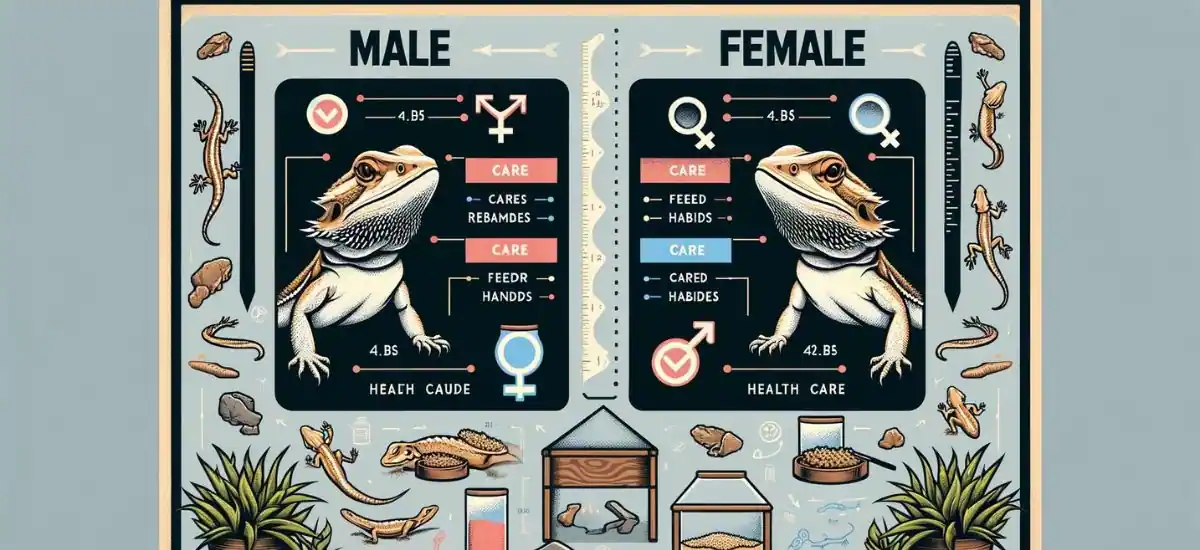When choosing between a male vs female bearded dragon, it’s essential to consider their distinct needs and behaviors.
Males are larger and more territorial, often requiring more space and more dynamic interaction. On the other hand, females tend to be smaller and less aggressive, making them potentially easier for first-time owners.
Both genders exhibit unique charms and challenges, so your choice should align with your ability to meet their specific care requirements. Ultimately, understanding these differences ensures that your bearded dragon not only survives but thrives under your loving care. ????
Physical Differences

Size and Weight Comparison
Males typically grow larger, up to 24 inches, while females often max out around 18 to 20 inches. This size variance is crucial for providing adequate living space.
Distinctive Features
- Head Shape: Males have broader, more triangular heads.
- Spikes: Males feature more pronounced spikes, enhancing their rugged appearance.
- Color Patterns: Males display brighter, more varied colors, especially during mating season to attract females.
The Hemipenal Bulge
A key gender identifier is the Hemipenal Bulge under the tail. Males have two bulges indicating hemipenes, whereas females have a single, less noticeable bulge. Recognizing this can help in providing appropriate care tailored to your bearded dragon’s gender.
Understanding these physical traits ensures your bearded dragon thrives in an environment suited to their specific needs.
Behavioral Differences
General Temperament
Bearded dragons exhibit distinct temperamental differences based on gender:
- Males tend to be more aggressive, especially during mating seasons or when establishing territory.
- Females generally display a calmer demeanor, but they can become territorial if their space feels threatened.
Mating Behaviors
During mating season, the behavioral differences are pronounced:
- Males perform vivid displays, such as head bobbing and arm waving, to attract females and deter rivals.
- Females might respond with submissive gestures like head nodding or remain indifferent.
Territory and Dominance
Both males and females establish and defend their territories, but the methods and intensity differ:
- Males often assert dominance through physical displays and may engage in conflicts if challenged.
- Females usually establish space more passively but can become aggressive if their nesting area is threatened.
Understanding these behavioral nuances helps in creating a harmonious environment for bearded dragons, minimizing stress, and promoting healthy interactions.
Know About: Bearded Dragon Shedding: Frequency And Care Tips
Health and Longevity
Understanding the health needs of your bearded dragon is vital. Males and females may face different health challenges, particularly related to the stress of breeding in females, which can affect their longevity. Females might also be prone to complications from egg-laying, making regular veterinary check-ups a must. ????
| Aspect | Male Bearded Dragons | Female Bearded Dragons |
| Lifespan Differences | Typically live 8-12 years. Lifespan can extend with optimal care. | Generally live 8-12 years, with proper care. |
| Common Health Issues | – Impaction from incorrect diet or substrate | – Impaction similar to males |
| – Metabolic Bone Disease (MBD) due to poor nutrition or lighting | – Metabolic Bone Disease (MBD) | |
| – Aggression-related injuries | – Calcium deficiencies during egg production, leading to MBD | |
| Impact of Breeding | Less directly affected by breeding. | – Breeding stress can lead to health complications such as egg binding and depletion of calcium. Frequent breeding without proper recovery time exacerbates these issues. |
This table format delineates the differences and similarities in health and longevity issues between male and female bearded dragons, providing a quick reference for owners or potential buyers.
Habitat Requirements

Space Needs
- Males require larger enclosures (minimum 75 gallons) due to their size and territorial behavior.
- Females can be housed in smaller spaces, with a recommended minimum of 50 gallons.
Environmental Setups
- Both genders need similar conditions, but males benefit from more complex environments with multiple hideaways and climbing areas to manage territorial behavior.
- Females need a stable environment with potential nesting areas if they are of breeding age.
Co-habitation
- Generally, not recommended to house males and females together due to risks of aggression, stress, and unplanned breeding.
Ensuring the right habitat size and setup tailored to each gender promotes health and well-being in bearded dragons.
Breeding Considerations
When and How Bearded Dragons Mate
Bearded dragons typically reach breeding maturity at around 18 months of age. Mating usually occurs in the spring, following their brumation period (a form of hibernation). During courtship, males display distinct behaviors like head bobbing, arm waving, and circling the female to gain her attention and show dominance.
Egg-laying and Incubation
After a successful mating, females will lay between 15 to 20 eggs about 4 to 6 weeks later. These eggs require careful incubation at a steady temperature of about 84-86°F (29-30°C). The incubation period typically lasts between 50 to 75 days. It’s essential to maintain humidity and temperature within these specific ranges to ensure healthy hatchlings.
Handling Gravid (Pregnant) Female Bearded Dragons
Gravid females need extra care to ensure their health and the health of their eggs. They require:
- Additional calcium supplements to prevent depletion due to egg production.
- A nesting area within their enclosure where they can lay their eggs comfortably.
- Increased monitoring to observe any signs of distress or health issues such as lethargy or reduced appetite.
Proper care during the breeding, egg-laying, and incubation phases is crucial to ensure the health of both the mother and the future hatchlings.
Feeding and Nutrition

Diet is paramount for both male and female bearded dragons, but there are nuances to consider. For instance, gravid females may require additional calcium to support egg development. Avoiding common feeding mistakes, like over-supplementation, can prevent health issues and ensure a balanced diet for your scaly friend. ????️
| Aspect | Male Bearded Dragons | Female Bearded Dragons |
| Dietary Differences | Males generally have a higher caloric requirement due to their larger size and more active nature. | Females, especially when gravid, may require more frequent feeding with smaller portions to support egg development. |
| Supplements and Vitamins | Both genders need calcium and vitamin D3, but males may require slightly less frequent supplementation if they are less active during non-breeding seasons. | Females need increased calcium during breeding seasons to support egg production and prevent health issues like metabolic bone disease. |
| Common Feeding Mistakes | – Overfeeding, leading to obesity<br>- Insufficient UV light exposure, affecting vitamin D synthesis | – Insufficient calcium, leading to health complications<br>- Over-supplementation, which can cause toxicity |
This table outlines the specific dietary needs and common pitfalls in feeding practices for male and female bearded dragons, emphasizing the importance of tailored nutrition and care.
Handling and Socialization
Tips for Handling Male and Female Bearded Dragons
- Gentle Handling: Approach bearded dragons calmly, supporting their entire body to make them feel secure.
- Regular Interaction: Frequent, gentle interactions help them become more comfortable with humans.
Social Interaction with Humans and Other Bearded Dragons
- Human Interaction: Build trust by hand-feeding and gentle petting.
- With Other Bearded Dragons: Introduce dragons to each other cautiously, as males can be territorial. Always supervise interactions.
Training and Enrichment Activities
- Feeding Toys: Encourage natural foraging behaviors with feeding toys suitable for both genders.
- Exploration Time: Allow safe, supervised time outside their tank for mental and physical stimulation.
- Obstacle Courses: Set up simple obstacle courses to promote activity and problem-solving.
These practices ensure a healthy, social, and active environment for bearded dragons, enhancing their overall quality of life.
Choosing the Right Pet for You
Deciding between a male or female bearded dragon involves considering your lifestyle and the dynamics of your household. Males might offer more dramatic displays and interactions, while females often have a calmer demeanor. Assess your capacity to meet their specific needs before making this exciting commitment. ????
| Aspect | Factors to Consider | Male Bearded Dragons | Female Bearded Dragons |
| Choosing the Right Pet | Consider your lifestyle and space availability. | Males: Larger and more territorial, need more space and attention. | Females: Generally smaller and less aggressive, easier to manage in smaller spaces. |
| Compatibility with Other Pets | Assess the existing pet dynamics in your home. | Males: Can be aggressive, not ideal with other males. | Females: More likely to cohabit peacefully with other females. |
| Household Dynamics | Consider the amount of time and interaction you can provide. | Males: Require frequent interaction to manage territorial behavior. | Females: Typically require less intensive interaction. |
| Pros and Cons | Evaluate based on your commitment to care and engagement. | Pros: Interactive, vibrant displays.<br>Cons: Can be aggressive and require larger habitat. | Pros: Generally calmer and easier for beginners.<br>Cons: Potential health issues from breeding. |
Frequently Asked Questions
1. Can male and female bearded dragons live together?
It’s generally not recommended as males can be aggressive and females may become stressed, especially during breeding seasons.
2. Are there any dietary differences between male and female bearded dragons?
Yes, males generally require more food due to their larger size, while gravid females need additional calcium to support egg development.
3. Do male and female bearded dragons show different levels of affection towards humans?
Both can be equally affectionate; however, individual personality plays a more significant role than gender in how sociable they are with humans.
4. Is it easier to care for male or female bearded dragons?
Females might be slightly easier due to their smaller size and less aggressive nature, but both genders require dedicated and proper care.
Read More: Essential Nutrients For Bearded Dragons


Leave a Reply
You must be logged in to post a comment.